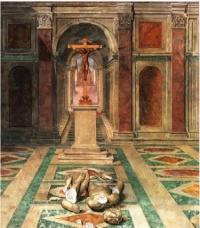Christian cross
From The Art and Popular Culture Encyclopedia

|
Related e |
|
Featured: |
The Christian cross is the best-known religious symbol of Christianity. It is a representation of the instrument of the crucifixion of Jesus Christ. It is related to the crucifix (a cross that includes a representation of Jesus' body) and to the more general family of cross symbols.
Pre-Christian cross-like symbols
The cross-shaped sign, represented in its simplest form by a crossing of two lines at right angles, greatly antedates, in both East and West, the introduction of Christianity. It goes back to a very remote period of human civilization. It is supposed to have been used not just for its ornamental value, but also with religious significance.
Some have sought to attach to the widespread use of this sign, in particular in its swastika form, a real ethnographic importance. It may have represented the apparatus used in kindling fire, and thus as the symbol of sacred fire or as a symbol of the sun, denoting its daily rotation. It has also been interpreted as the mystic representation of lightning or of the god of the tempest, and even the emblem of the Aryan pantheon and the primitive Aryan civilization.
Another symbol that has been connected with the cross is the ansated cross (ankh or crux ansata) of the ancient Egyptians, which often appears as a symbolic sign in the hands of the goddess Sekhet, and appears as a hieroglyphic sign of life or of the living. In later times the Egyptian Christians (Copts), attracted by its form, and perhaps by its symbolism, adopted it as the emblem of the cross. In his book, The Worship of the Dead (London, 1904), p. 226, Colonel J. Garnier wrote: "The cross in the form of the 'Crux Ansata' . . . was carried in the hands of the Egyptian priests and Pontiff kings as the symbol of their authority as priests of the Sun god and was called 'the Sign of Life'."
In the Bronze Age we meet in different parts of Europe a more accurate representation of the cross, as conceived in Christian art, and in this shape it was soon widely diffused. This more precise characterization coincides with a corresponding general change in customs and beliefs. The cross is now met with, in various forms, on many objects: fibulas, cinctures, earthenware fragments, and on the bottom of drinking vessels. De Mortillet is of opinion that such use of the sign was not merely ornamental, but rather a symbol of consecration, especially in the case of objects pertaining to burial. In the proto-Etruscan cemetery of Golasecca every tomb has a vase with a cross engraved on it. True crosses of more or less artistic design have been found in Tiryns, at Mycenæ, in Crete, and on a fibula from Vulci.

